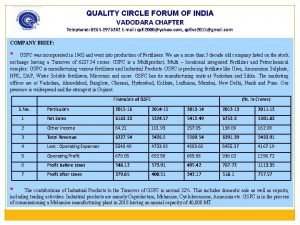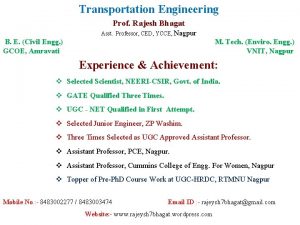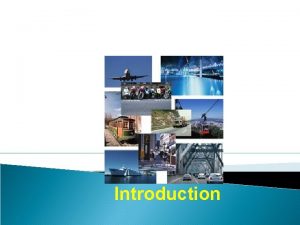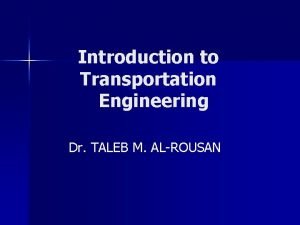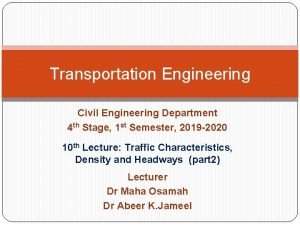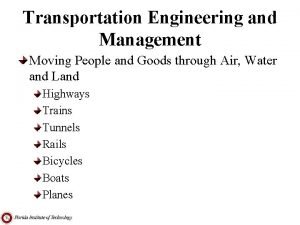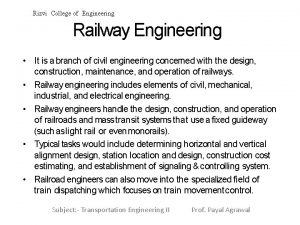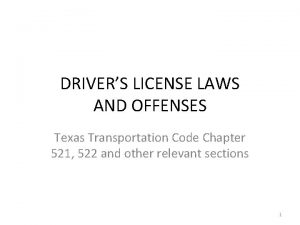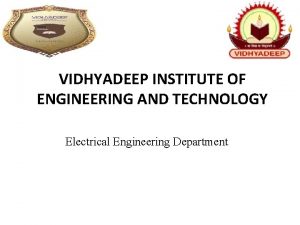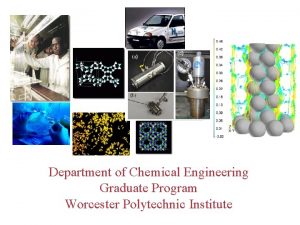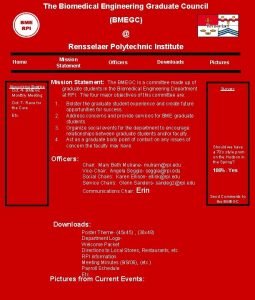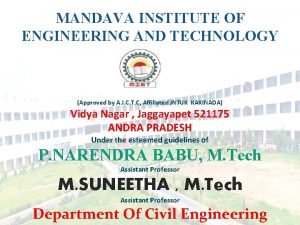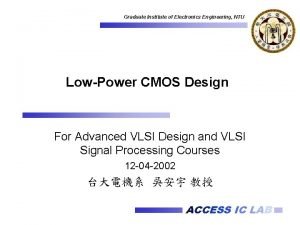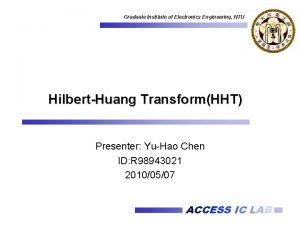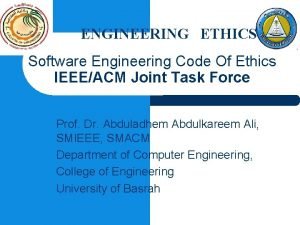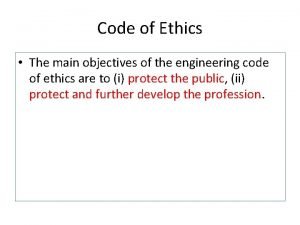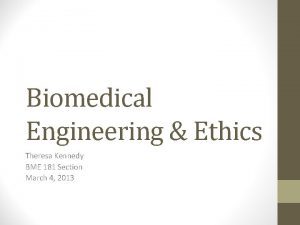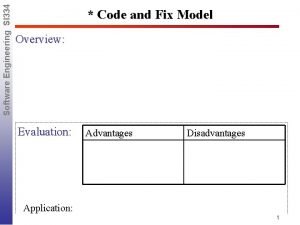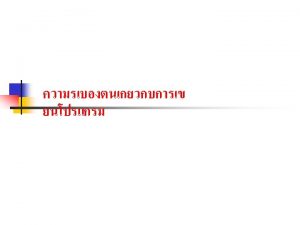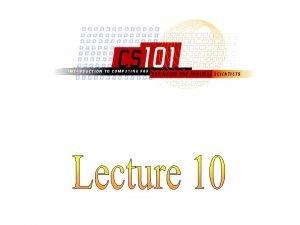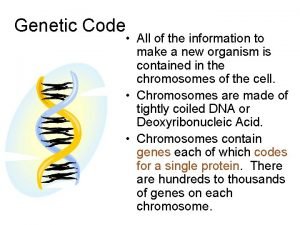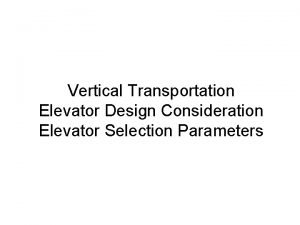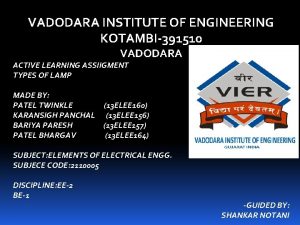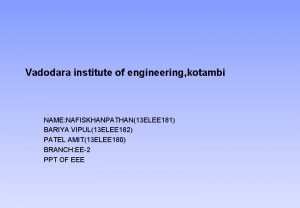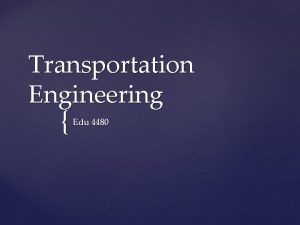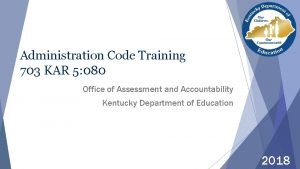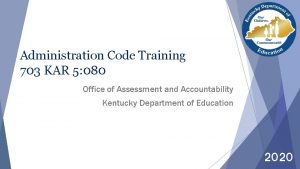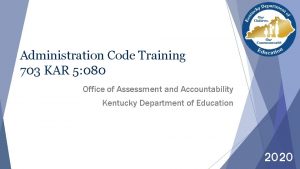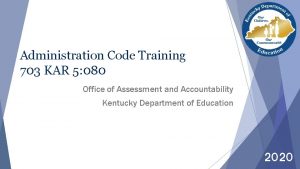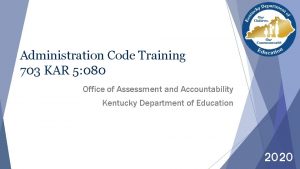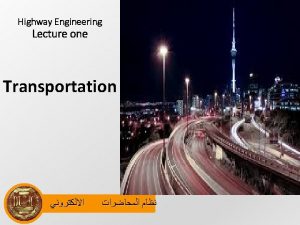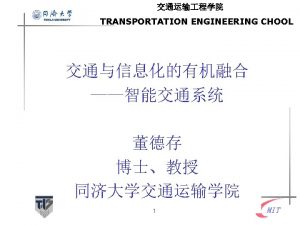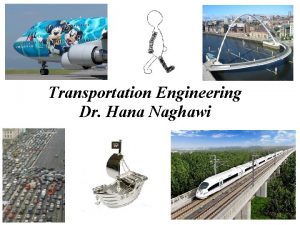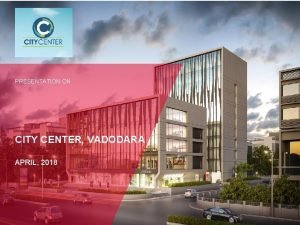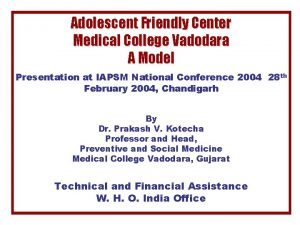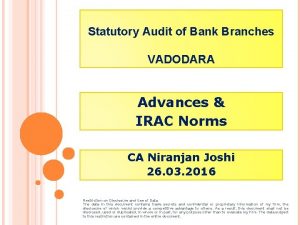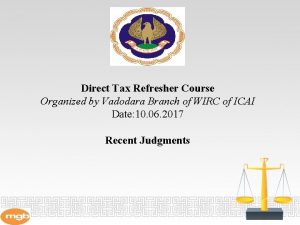VADODARA INSTITUTE OF ENGINEERING INSTITUTE CODE 080 TRANSPORTATION


















































- Slides: 50

VADODARA INSTITUTE OF ENGINEERING INSTITUTE CODE : 080

TRANSPORTATION ENGINEERING Name and enrollment no. : Nimkar Sagar 130800119045 Raj Jariwala Subject Branch & Division 130800119087 : ELEMENTS OF CIVIL ENGINEERING : MECHANICAL -II Semester : I Academic year : 2013 -14 Guide : Asst. Prof. Megha Patel

TRANSPORTATION ENGINEERING • MECHANICAL ENGINEERING. VADODARA INSTITUTE OF ENGINEERING.

INTRODUCTION Transportation eng. Is the application of technological and scientific principle to the planning, functional design, operation, and management, of facilities for any mode of transportation in order to provide for the safe, rapid, comfortable, convenient, economical, environmentally compatible movement of people and goods. Transportation eng. is practiced by policymakers, managers, planners, designers, engineers, operating and maintenance specialist and evaluators.

TRANSPORTATION The desire of people to move and their need for goods create the demand for transportation. People ‘s preferences in terms of time, money and comfort, and convenience . A review of descriptions of the scope of various committees indicates that while facility planning and design continue to be the core of the transportation engineering field, such areas as operations planning, logistics, network analysis, financing, and policy analysis are also important to civil engineers, particularly to those working in highway and urban transportation.

TYPES OF TRANSPORTATION Road ways Rail ways Air ways Water ways

THE EFFICIENCY OF A TRANSPORT MODE Speed Safety Adequacy Frequency Integration Responsibilities Comfort Cheapness Fuel efficiency Employment generation Travel time

ELEMENTS OF MODES OF TRANSPORTATION Mode of transportation way User Vehicle terminal Road ways Roads pedestrian, Passenger , Cycle, Bus, Truck, 2 w, 4 w , 3 w Own residents, parking lots, employment location Railways Railway tracks Passengers Locomotives, Coaches, wagons stations Water ways Shipping lines Passengers Ships, Boats Harbors Airways Air routes Passengers Aircrafts airports

EFFECT OF WELL DEVELOPED ROAD NETWORK ON THE DEVELOPMENT OF THE COUNTRY. Well developed road network provides mass and rapid transportation of passengers and goods. People of country make faster, safer and comfortable journey from one place to another. Connectivity make exposure to urban and well developed area. Industries and other employment sectors will grow due to availability of good employers. Employers living standard increases by good absorbent. The raw materials and finished goods can be transported easily, safely and faster.

ROAD WAYS All the roads do not cater for the same amount of a traffic volume or intensity. The roads are classified as per traffic volume, tonnage of road transported, location and function.

ROAD DEVELOPMENT IN INDIA For proper planning of road network in India a conference of a chief engineers was held at Nagpur in 1943. One by one three 20 years road development programs for were planned for India Nagpur road plans-1943 -63. Bombay road plans- 1961 -81. Lucknow road plans-1981 -2001

CLASSIFICATION OF ROADS ACCORDING TO POSITION IN NATIONAL NETWORK OF ROADS National highways: They are main highways running through the length and breath of the nation connecting major ports foreign high ways, states & other local roads. State high ways: They are arterials roads of a state connecting up with a national high ways of adjacent state & important cities with in state and district. Major district road: They are the important roads with in the district serving areas of production and markets or with highways of a district.

Other district roads : They are the roads serving rural area, market centers, taluka & other main roads. Village roads: They are the roads connecting villages or group of villages with each other to the nearest road of a higher category.

ADVANTAGES OF ROAD WAYS Road ways has maximum flexibility for travel with reference to route, direction, time and speed of travel. Road ways serve feeder system of railways, airways and waterways. For short distance travel road transport saves time. Transportation to the interior parts , rural areas is convenient by the roads way. Roadways provide door to door service. Roadways are cheaper than rail , water and air carrier.

DISADVANTAGES OF ROADWAYS Passenger and goods carrying capacity is low compared to railways and waterways. Speed is low compared to railways and airways. Suitable for small distance. Maintenance of roadways should be regular otherwise comfort and safety is less. Uncomfortable and uneconomical for long distance travel. Number of accidents are high.

RAILWAYS Railways can handle large number of passengers through coaches containing train movement on rails. Railways can transport tonnes of goods perishable and non-perishable for long distance through closed and open wagons containing goods of train movement on rails. Railways can be used by definite type of vehicles only it can carry out transportation on fixed routes between fixed stations. There is no flexibility of route, stoppage or vehicles.


ADVANTAGES OF RAILWAYS It facilitates long distance travel and transport of bulky goods which are not easily transported through motor vehicles. It is a quick and more regular form of transport because it helps in the transportation of goods with speed and certainty. It helps in the industrialization process of a country by easy transportation of coal and raw-materials at a cheaper rate. It helps in the quick movement of goods from one place to another at the time of emergencies like famines and scarcity. Railway is the safest form of transport. The chances of accidents and breakdown of railways are minimum as compared

DISADVANTAGES OF RAILWAYS The passengers and goods transported by trains can be loaded and unloaded from stations and yards only. They are dependent on roadways to reach to station or yard and to desired points. Maintenance cost is high. The trains run as per schedule. Their arrival and departure time is fix. Definite vehicles can only run on railways. Accident cause high loss. Initial construction cost of railway stations , platforms, tracks, trains etc. is high.


WATER WAYS A waterway is any navigable body of water. A shipping route consists of one or several waterways. Waterways can include rivers, lakes, seas, oceans, and canals. In order for a waterway to be navigable, it must meet several criteria: The waterway must be deep enough to allow the draft depth of the vessels using it. The waterway must be wide enough to allow passage for the beam width of the vessels using it. The waterway must be free of barriers to navigation such as waterfalls and rapids, or have a way around them (such as canal locks and boat lifts. The current of the waterway must be mild enough to allow vessels to make headway. Vessels using waterways vary from small animal-drawn barges to immense ocean tankers and ocean liners, such as cruise ships.

ADVANTAGES OF WATERWAYS The waterways is the gift of nature. No need the of constructing tracks or path. Cheapest mode of transportation. It provides an efficient mean of defense for national security. It possesses high load capacity. Large volume of goods , cargo , materials , can be transported goods. It requires cheap motive power for its working. Tonnage of load of men and materials can be transported with small amount fuel consumption.

DISADVANTAGES OF WATERWAYS It is slow. due to slow speed and circuitous routes travel time is more. Ocean storms and hurricanes cause great loss of cargo. It permits definite routes and limited connectivity. It is useful along the particular routes only where water is available as a mode of transportation It is depended on another modes of transportation. Road or rail network is required as a feeder for water transportation.


AIR WAYS Air transport is that the most up-to-date origin within the arena of transport system of any country. owing to the quick transit of products and folks via airways, the planet Cheap international air ticket tag economy has seen progress due to the actual fact that airways are ready to do everything in fast succession of your time. Air ways are continuous faster but costlier ways of transportation. Capacity to handle traffic is limited

ADVANTAGES OF AIRWAYS High speed- Airways is that the fastest manner of transportation and so it’s got supersonic speed that guarantees that everything reaches its destination on time. For the urgent demand of products, there’s no substitute for air transport. Fast Service- Quick service is another advantage of airways. It provides fast, sleek and well managed service. No infrastructure need- It doesn’t require the development of rail tracks like railways. Thus, it’s a low cost mode of travel. No physical barrier- Aircrafts will simply take folks on to their destinations regardless of any obstruction like seas, mountains or forests. Quick Clearance- due to the short custom clearance, it saves time and one is prepared to fly in a very jiffy.

DISADVANTAGES OF AIRWAYS Most expensive. Travel cost is high. Weather cond. Should be favorable for flight schedules. Construction cost of airports and airplanes is high. Fuel consumption is high. Special training is to be given to the pilots, air hostesses and airport staff. Maintenance cost of runways taxiways like airfield and airport components is high. Due to accident loss is high.


TRAFFIC ENGINEERING (TRANSPORTATION)

TRAFFIC ENGINEERING Traffic engineering is a branch of civil engineering that uses engineering techniques to achieve the safe and efficient movement of people and goods on roadways. It focuses mainly on research for safe and efficient traffic flow, such as road geometry, sidewalks and crosswalks, segregated cycle facilities, shared lane marking, traffic signs, road surface markings and traffic lights. Traffic engineering deals with the functional part of transportation system, except the infrastructures provided

TRAFFIC ENGINEERING IS CLOSELY ASSOCIATED WITH OTHER DISCIPLINES: Transport engineering Pavement engineering Bicycle transportation engineering Highway engineering Transportation planning Urban planning Human factors engineering.

OBJECTIVES OF TRAFFIC ENGINEER While speed of travel is much to be desired, it is limited by transportation technology, human characteristics, and the need to provide safety. Comfort and convenience are generic terms and mean different things to different people. Comfort involves the physical characteristics of vehicles and roadways , and is influenced by our perception of safety. Convenience relates more to the ease with which trips are made and the ability of transport systems to accommodate all of our travel needs at appropriate times.

Economy is also relative. There is little in modern transportation systems that can be termed “cheap. ”Highway and other transportation systems involve massive construction, maintenance, and operating expenditures, most of which are provided through general and user taxes and fees. Nevertheless, every engineer, regardless of discipline, is called upon to provide the best possible systems for the money.

PURPOSE OF STUDY OF TRAFFIC VOLUME: 1. 2. 3. 4. 5. 6. Establish relative importance of any road. Planning, designing and regulation of traffic. Structural design of road. Planning and design of new streets. Establishment properties and schedules for traffic improvements. Design of intersection and other control devices.

TRAFFIC CONTROLLING DEVICES : Generally following four devices are provided on road to control the traffic: 1. Road signs 2. Markings 3. Signals 4. Traffic islands

ROAD SIGNS: Roads signs are provided to warn, direct and guide the road users. They are in the form of symbols or inscription. They are mounted on fixed or portable supports and are placed on the side of roads.

REGULATORS OR MANDATORY SIGNS : These signs are used to inform the road users, certain rules and regulations which has to notice for safe and free flow of traffic. o Some of the regulatory signs are: A. Give way and stop signs: o

B. PROHIBITORY SIGNS :

C. SPEED LIMIT AND VEHICLE CONTROL SIGNS:

D. NO PARKING, NO STOPPING SIGNS:

THE VARIOUS WARNINGS SIGNS USED ARE:

Ø INFORMATORY SIGN :

These are road signs used to guide road users along route, inform them about destination and distance , and provide other information so as to make the road travel easier and safe. o. An informatory sign usually consist of a rectangular board of specified size. In case of facility information signs, the size of rectangle shall be 800 mm x 600 mm for normal signs and the size of square shall be 400 mm and 300 mm. o


Ü MARKINGS : Traffic markings are the lines, patterns, words, symbols or reflectors applied to the carriage way, curves, sides of islands or to fixed objects near the road way. • The objects of the traffic marking is to warn , inform and guide the road users. They are made by using prints in contrast with colors and brightness on pavements or other background. Ordinary paints like oil paints are used for road markings. •


TRAFFIC CONTROL ELEMENTS

COMPONENTS OF TEMPORARY TRAFFIC CONTROL ZONES Most temporary traffic control zones are divided into four areas: Advance warning area, Transition area Activity area Termination area.


O Y K N A H T ! ! U
 Qcfi vadodara
Qcfi vadodara Rishabh group vadodara
Rishabh group vadodara Generate club080
Generate club080 Code commit code build code deploy
Code commit code build code deploy Transportation engineering by rajesh bhagat
Transportation engineering by rajesh bhagat About the bed
About the bed Definition of transportation engineering
Definition of transportation engineering Transportation engineering definition
Transportation engineering definition Transportation engineering
Transportation engineering Transportation engineering
Transportation engineering Railway engineering
Railway engineering Lofs 21 or over texas
Lofs 21 or over texas Vidhyadeep institute of engineering and technology
Vidhyadeep institute of engineering and technology Graduate institute of electronics engineering
Graduate institute of electronics engineering Worcester polytechnic institute chemical engineering
Worcester polytechnic institute chemical engineering Grenoble institute of engineering
Grenoble institute of engineering Stevens institute of technology mechanical engineering
Stevens institute of technology mechanical engineering Rensselaer polytechnic institute electrical engineering
Rensselaer polytechnic institute electrical engineering Rensselaer polytechnic institute biomedical engineering
Rensselaer polytechnic institute biomedical engineering Mandava institute of engineering and technology
Mandava institute of engineering and technology Higher institute of engineering el shorouk
Higher institute of engineering el shorouk Fromme423
Fromme423 Electronic engineering polytechnic institute of surabaya
Electronic engineering polytechnic institute of surabaya Ntu
Ntu Graduate institute of electronics engineering
Graduate institute of electronics engineering Graduate institute of electronics engineering
Graduate institute of electronics engineering Graduate institute of electronics engineering
Graduate institute of electronics engineering Aiche code of ethics
Aiche code of ethics Dhaka polytechnic institute subject
Dhaka polytechnic institute subject Pima medical institute dress code
Pima medical institute dress code System procurement process in software engineering
System procurement process in software engineering Forward engineering and reverse engineering
Forward engineering and reverse engineering Engineering elegant systems: theory of systems engineering
Engineering elegant systems: theory of systems engineering Engineering elegant systems: theory of systems engineering
Engineering elegant systems: theory of systems engineering Forward and reverse engineering
Forward and reverse engineering Software engineering code of ethics
Software engineering code of ethics Software engineering code of ethics
Software engineering code of ethics Software engineering ethics
Software engineering ethics Engineering code of conduct
Engineering code of conduct Full scale in engineering drawing
Full scale in engineering drawing Biomedical engineering society code of ethics
Biomedical engineering society code of ethics Coughent
Coughent Code and fix model in software engineering
Code and fix model in software engineering Code élaboré code restreint
Code élaboré code restreint Managed code unmanaged code
Managed code unmanaged code Apa itu assembler
Apa itu assembler Difference between source code and machine code
Difference between source code and machine code Code switching and code mixing
Code switching and code mixing Trace the code genetic code table
Trace the code genetic code table First water transport
First water transport Vertical transportation design
Vertical transportation design
